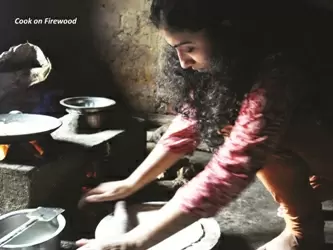Experiencing rural life is the new fad for the urban tourist
22-December-2014
Vol 5 | Issue 51
From visits to centuries-old villages to experiencing forest trails to participating in village festivals and carrying out traditional day-to-day agricultural activities, the urban tourist is going rural these days.
Commonly referred to as rural or responsible tourism, it entails participation from the traveller as well as the host community, where the former partakes in the community's day-to-day-activities and in turn contributes to reducing migration by creating employment opportunities and also registering an increase in the average annual household income.
 |
|
A traveller cooking a meal on firewood (Photo: IANS)
|
"Nowadays, people are looking to do something worthwhile while on a holiday. Hence, there has been an increase in experiential tourism," says Inir Pinheiro, founder of Grassroutes, which improves livelihoods in rural India through community-managed rural tourism and experiential learning programmes.
"Rural tourism is one aspect of experiential tourism as it gives people a chance to do something on a holiday - be it farming, petting animals, eating fresh fruits and vegetables or just running around in farms and villages," Pinheiro said, adding that Grassroutes operates in three Maharashtra villages.
According to Union Minister of Culture and Tourism, Mahesh Sharma, rural tourism has "immense potential" that would be "completely" explored.
"We (the tourism ministry) treat rural tourism as a separate entity and we will have different funds for this. It is very important to invest in rural tourism to prevent rural to urban migration," said Sharma.
According to the ministry, tourism in India contributed 6.88 percent to the GDP. So far, the ministry has sanctioned 153 rural tourism projects in 28 states/union territories, including 36 sites where UNDP has provided support for capacity building.
According to the ministry, "any form of tourism that showcases the rural life, art, culture and heritage at rural locations, thereby benefiting the local community economically and socially as well as enabling interaction between the tourists and the locals for a more enriching tourism experience, can be termed as rural tourism".
Like Grassroutes, there are other initiatives like India Untravelled and One Planet that are designed to minimize the carbon footprint, encourage local participation and journey off the beaten track.
"The people we work with are all locals, as per our policy. Whether training them in hospitality, or they working more or less independently, is empowering for them.
“They are leading our village walks, guiding foreign guests - their language skills improving with every interaction - and managing the accounts. So, by keeping our role to that of only overseeing things, all our associates have been empowered," says Shikha Tripathi, co-founder of One Planet.
Started in 2012, One Planet specialises in Uttarakhand's Kumaon region. Its activities encompass Almora and Binsar, as also walking trails in the high-altitude regions of remote Kumaon.
According to R.P. Mitra, assistant professor in Delhi University's Department of Anthropology, the sudden boost in rural tourism is a "new-found love" for the urban traveller, especially the present generation that seems to be detached from the rural lifestyle.
"Also, the imagination and the kind of media portrayal of rural society have created a sense of inquisitiveness. Additionally, the traditional tourist places are saturated so people want new experiences and the rural society offers them that," said Mitra.
He, however, pointed out that the nature and level of "outsider involvement" were important and needed to be taken care of since rural tourism can be successful if tackled from the right perspective.
Does it not take an effort to convince locals to be a part of the initiative?
"Developing a village tourism destination involves mobilizing local villagers and communities, facilitating investors and local village communities to come together to create a destination that is owned, managed and run by local village communities, training of villagers, infrastructure support and building of village tourism committees and ensuring profitability of the destination.
“This takes time. We are able to develop a village tourism destination in one-two years," Pinheiro explained.
Agreed Tripathi, who said that the trust factor plays a major role here.
However, do not such initiatives make the community's economy dependent on a single entity, making it susceptible? And, with such urban influx, will the rural essence not get lost?
"It has negative effects if you open up the sector in a big way. It will then attract a host of things like hotels and allied industries along with the outsiders. So, it is important to see how well it is planned and how well the local community is involved," Mitra summed up. - IANS














